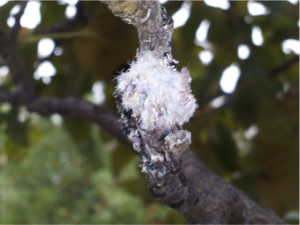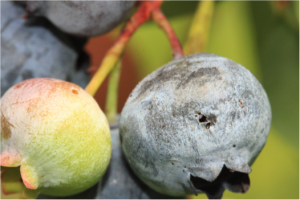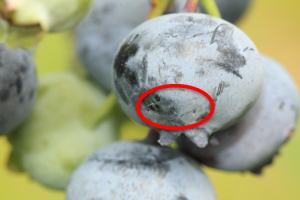Peach:
Oriental Fruit Moth (OFM): The 3rd OFM flight is well underway in all counties. These adults produce 3rd brood of larvae, which primarily infest the fruit.
As with the previous generations, timing for the third generation depends on the type of material that is used. Application timings are as follows:
| OFM 3rd Generation Timing | ||||
| Insecticide Type | ||||
| County/Region | Degree Days by 7/13 base 45 | Conventional
Target – 2100-2200, 2450-2500 |
Intrepid / IGRs
Target -2050-2100, 2400-2450 |
Diamides (Altacor, Exirel
Target – 2025-2150, 2375-2450 |
| Gloucester – Southern | 2132 | 1st – 7/12-7/15
2nd – 7/23-7/24 |
1st – 7/11-7/12
2nd – 7/21-7/22 |
1st – 7/10-7/13
2nd – 7/20-7/22 |
| Hunterdon – Northern | 1828 | 1st – 7/22-7/24
2nd – About 7/30-8/2 |
1st – 7/21-7/23
2nd – About 7/28-7/30 |
1st – 7/20-7/21
2nd – About 7/27-7/28 |
Brown Rot: Most growers should be done with sulfur on anything but the late varieties that ripen during the second half of August and later. Anything now ripening through early August should be on the improved fungicide program. This means a rotation of DMI Group 3 materials (Indar, Orbit, Orius, Quash) with 7 (Fontelis), 11(Gem), and premix combinations. Please be aware that Quadris Top is a combination that includes the same AI as in Abound, so can be phytotoxic to apples. Inspire Super is a combination of a DMI (Group 3) and the AI in Vangard, and Vangard is not particularly effective for the fruit phase of brown rot.
Thrips: We have not seen any thrips build-up yet. However, prolonged hot dry weather is always favorable to thrips. If you notice any thrips in the coming weeks, then consider Delegate @ 6-7 oz/ac, or Lannate SP @ 1#/A (or LV @1.5-3 pt/A). The addition of a non-ionic surfactant can help improve control. Delegate has a 1 day PHI for peach/nectarine, and Lannate has a 4 day PHI on peach.
Japanese Beetle (JB) and other Scarab Beetles: Japanese beetle adults are present at low numbers in all counties. Very little fruit damage has occurred. Most insecticides will control these insects but the best materials are formulations containing Imidacloprid (Admire Pro; Leverage); Carbaryl (Sevin); Phosmet (Imidan); or Fenpropathrin (Danitol). These materials, except Danitol, are not effective for BMSB, but few to “0” BMSB are present in orchards.
Brown Marmorated Stink Bug (BMSB): Very low populations are present so far in both peach and apple orchards. Given the fact that many of the materials that control Japanese beetle (above), do not control BMSB, growers may wish to focus on JB if present, and BMSB is absent.
Apple:
Codling Moth (CM): The timing of the first spray for second brood control should commence at 1150 to 1250 degree days after Biofix, depending on the material used. The second applications are due in southern counties by early next week. The first applications are due in northern counties now, and through most of this week, depending on the material used. A second application will be due near the end of the month for northern counties. Second generation populations can often be delayed by 100-150 degree days, and stretch later in the season. Therefore a third application may be required in these problem areas.
| Codling Moth Degree Day Timing – Model Predictions | ||||||||
| Application and Insecticide Type | ||||||||
| County Area | Biofix | Rimon:
1150-1200 DD + 14-17 days later, or 1450-1500 DD
|
Intrepid and
Diamides – Altacor, Exirel, Voliam mixes: 1200-1250 DD + 1550-1600 (14-21 days later) |
Cyd-X, Madex, Carpovirusine
1250 DD + every 7-9 days during brood hatch (later if first spray is an IGR) |
Standard Insecticides – Delegate, Avaunt, OP’s, carbamates, pyrethroids
1250-1300 DD + 1600-1650 DD
|
|||
| DD | 1150 | 1200 | 1250 | 1550 | 1250 | 1250 | 1600 | |
| Southern | April 26 | Past | Past | Past | 7/16 | Past | Past | 7/18 |
| Northern | May 2 | 7/11 | 7/12 | 7/14 | 7/27-29 | 7/14 | 7/14 | 7/29-31 |
Fire Blight: Fire blight is still present in a number of orchards. Now is a good time to cut out infected shoots since the trees are entering a brief hardening off period. Cutting out the infected shoots, followed by regular applications of copper may help arrest further spread by killing any exposed bacteria. See previous newsletters for copper suggestions.
Woolly Apple Aphid (WAA): WAA colonies are present in several orchards in northern counties (Figure 1). Levels range from 10 to 13 colonies per tree. Controls for this insect are Very Limited. Therefore, you cannot let WAA get out of control, and must control this generation if present. WAA colony growth can be aggravated by repeated pyrethroid use, as well as Delegate use. Applications with Movento @8-9 fl oz/A combined with a spreader/penetrant should offer the best control. This is a systemic material, and MUST BE applied with the spreader/penetrant adjuvant, Not a sticker. Movento will not work well later in the season when the leaf tissue is thicker and less able to absorb the product. This is one reason why earlier control is better than later control. This application will be more effective if used in a full cover/every middle application. Apply at dusk or very early in the morning in sufficient water volume for maximum absorption and to slow down the drying time.

Figure 1. Woolly apple aphid colony on apple tree.
European Red Mite (ERM): Mite populations continue to build in individual orchards. Reports of Zeal (Valent – IRAC group 10B – etoxazole @ 2-3 oz/A) and Nealta (BASF-IRAC group 25 – cyflumetofen @ 13.7 oz/A) use have been successful. Nealta is not labeled for stone fruit. As per the product label, mite control is improved when Nealta is applied with a wetting agent. Predators are also present feeding on mite populations, especially lacewing larvae and predaceous mites.
Summer Disease Control Including Bitter Rot: 1st and 2nd cover spray timing is when Bitter Rot infections start to become established and then show up later in the season. Of course that earlier timing has past, but we are still within the later infection windows. Effective mixtures have included Captan 80WDG @ 3-4 lb/A (up to 5 lb/A) and combine Captan with Flint or Sovran (FRAC 11), or Topsin-M (FRAC 1), or Pristine (FRAC 11,7). A recent post from Dr. Dave Rosenberger (Cornell retired) See – https://blogs.cornell.edu/plantpathhvl/files/2017/07/17-07-New-bitter-rot-control-strategies-sjjc9c.pdf summarizes some recent research on bitter rot control. The article discusses research that combined Fontelis or Aprovia with Captan for improved bitter rot control. Note that while Aprovia does list bitter rot suppression on the label, Fontelis is labeled for scab and alternaria at this time of year. Fontelis has a 28 day PHI on apples and Aprovia has a 30 day PHI, so we are only talking about 1-2 applications. Fontelis has shown to have some phytotoxic properties early in the season.
Blueberry:
Spotted Wing Drosophila (SWD): Adult trap captures have increased. This is likely a result of decreased spraying in ‘Duke’ fields, as well as the natural population increase we get during mid July. With multiple generations per season, the numbers at this time of year can be staggering. We cannot stress enough that insecticide programs need to be continued for the protection against this pest. Even though some growers are finishing up ‘Bluecrop,’ and machine picking, remember that the tolerance for infested fruit of any kind or market is ‘0’. We continue our salt tests for field run harvested fruit, and can report ‘0’ larvae found in all tests from commercially treated fields. We also did testing this week on fruit from 2 unsprayed fields, and found numerous infested fruit. A visit to one of those fields showed many infested berries, and fruit with freshly laid eggs (Figures 2-4). This is an obvious demonstration on the importance of continued treatments during this time of rapid population growth.

Figure 2. Hanging berry with holes from SWD egg laying and establishment.

Figure 3. Hanging berries with freshly laid eggs just under the skin surface. Note circled egg breathing tubes on surface.

Figure 4. SWD larva from untreated blueberry field – July 12.
Aphids: Aphid populations are close to the same levels as seen last week, and higher on some farms. High populations provide more opportunity to spread scorch virus, and should be controlled. If berries are off the bush and aphid populations are still high, then growers should think about ground applied insecticides to control high aphid populations.
Blueberry Maggot (BBM): Trap captures are very low to non-existent, except in a few areas in Atlantic County, where trap counts reached 16 flies per trap. When trap captures exceed 1 fly per trap, then chances of having infested fruit increase. Normal insecticide programs for SWD should control BBM populations.
Oriental Beetle (OB): Oriental beetle adult trap captures have peaked, and should show a downward trend for the remainder of the season. The treatment window for Oriental Beetle grubs is now coming to a close. Applications of imidacloprid made after this week will not be very effective, since the grubs will be larger 3rd instars, and not susceptible to the insecticide. Growers who have not treated, or wish to use an alternative control, should order mating disruption dispensers for 2018, and place them in the fields during May.
Sharpnosed Leafhopper (SNLH): SNLH adults are still present, but have decreased slightly since the previous week. This is the 1st generation starting to die off. A second generation should appear in late August.
Putnam Scale: Scale crawlers are still present, but treatments are not suggested, since this is close to the end of the 1st generation crawler stage. We will keep you posted on the status of second generation crawlers, and spray timing in August.
Grape:
Grape Berry Moth (GBM): Degree accumulations since the biofix on 5/16 indicate that the timing for the 3rd generation treatments will be on 7/19 using the Skybit calculations or 7/18 using the Cornell NEWA calculations. This timing is for the insect growth regulator, Intrepid, and diamide materials like Altacor. Other materials like pyrethroids can be used several days later (2-3) in this hot weather.
Tree Fruit Trap Counts – Southern Counties
| Week Ending | STLM | TABM-A | CM | AM | OFM-A | DWB | OFM-P | TABM-P | LPTB | PTB |
| 4/8 | 32 | 0 | ||||||||
| 4/15 | 43 | 135 | 5 | 0 | ||||||
| 4/22 | 20 | 0 | 1 | 81 | 24 | 0 | 0 | |||
| 4/29 | 0 | 0 | 0 | 95 | 3 | 0 | 0 | |||
| 5/6 | 7 | 7 | 15 | 23 | 4 | 2 | 37 | |||
| 5/13 | 0 | 7 | 15 | 92 | 2 | 2 | 12 | |||
| 5/20 | 2 | 3 | 10 | 34 | 0 | 2 | 35 | |||
| 5/27 | 2 | 10 | 6 | 11 | 0 | 17 | 62 | |||
| 6/3 | 13 | 12 | 11 | 23 | 0 | 13 | 47 | 1 | ||
| 6/10 | 10 | 10 | 3 | 1 | 1 | 8 | 30 | 2 | ||
| 6/17 | 50 | 25 | 3 | 23 | 3 | 2 | 15 | 29 | 0 | |
| 6/24 | ||||||||||
| 7/1 | 60 | 2 | 4 | 50 | 16 | 1 | 8 | 27 | 4 | |
| 7/8 | 16 | 1 | 5 | 0 | 40 | 4 | 0 | 0 | 9 | 12 |
Tree Fruit Trap Counts – Northern Counties
| Week Ending | STLM | TABM-A | CM | AM | OFM-A | DWB | OBLR | OFM-P | TABM-P | LPTB | PTB |
| 5/6 | 25 | 0 | 2 | 6 | 0 | 10 | 0 | 2 | 0 | ||
| 5/13 | 43 | 0 | 2 | 4 | 0 | 2 | 0 | 1 | 0 | ||
| 5/20 | 6 | 0 | 2 | 1 | 0 | 1 | 0 | 18 | 1 | ||
| 5/27 | 7 | 7.7 | 8.3 | 1.2 | 0 | 2 | 5 | 27.4 | 1.2 | ||
| 6/3 | 24 | 23 | 7 | 0.3 | 3 | 21.5 | 2 | 24.8 | 29.9 | 0.3 | |
| 6/10 | 64 | 19.8 | 6 | 2.8 | 0.8 | 5 | 1.5 | 25.3 | 19.7 | 0.8 | |
| 6/17 | 108 | 26.9 | 4.4 | 4.8 | 3.3 | 29 | 3.3 | 27.2 | 38.7 | 1.9 | |
| 6/24 | 101 | 23.4 | 4.5 | 4.5 | 1.7 | 22 | 3 | 34.4 | 18.7 | 0.8 | |
| 7/1 | 88 | 16.6 | 2.1 | 1.5 | 5.6 | 7 | 1 | 8.5 | 19.3 | 6.1 | |
| 7/8 | 86 | 5.7 | 0.8 | 1 | 10.4 | 0 | 1 | 0.3 | 18.7 | 2.8 |
Blueberry Trap Counts
Atlantic County
| Week Ending | Cranberry Fruitworm | Plum Curculio | Oriental Beetle | Spotted Wing Drosophila ♂ | SNLH | BBM |
| 5/6 | ||||||
| 5/13 | 0.083 | |||||
| 5/20 | 0.28 | 2.4 | ||||
| 5/27 | 0.56 | 2.8 | ||||
| 6/3 | 0.24 | 0.33 | 0.74 | |||
| 6/10 | 0.33 | 0 | 4.9 | 0.79 | ||
| 6/17 | 0.50 | 0 | 730 | 1.65 | 0 | 0.1 |
| 6/24 | 0.04 | 0 | 2672 | 1.2 | 0.29 | 0.1 |
| 7/1 | 0.04 | 0 | 3767 | 1.84 | 0.13 | 0.3 |
| 7/8 | 0.0 | 0.33 | 3341 | 5.02 | 0.09 | 0.1 |
Burlington County
| Week Ending | Cranberry Fruitworm | Plum Curculio | Oriental Beetle | Spotted Wing Drosophila ♂ | SNLH | BBM |
| 5/6 | ||||||
| 5/13 | 0.33 | |||||
| 5/20 | 0.14 | 7 | ||||
| 5/27 | 0.43 | 12 | ||||
| 6/3 | 0.857 | 2 | 2.46 | |||
| 6/10 | 0.18 | 0 | 1.08 | 1.83 | ||
| 6/17 | 0.9 | 1.0 | 269 | 3.08 | 0 | |
| 6/24 | 0.67 | – | 5460 | 3.04 | 1.59 | 0 |
| 7/1 | 0.36 | 0 | 2629 | 4.64 | 1.03 | 0 |
| 7/8 | 0.17 | 0 | 4224 | 5.53 | 1.07 | 0.23 |

